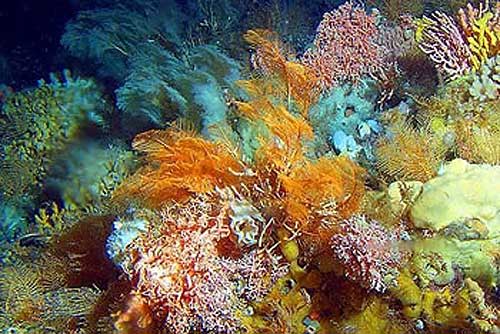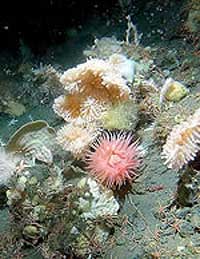 by Doug Schneider November 18, 2003 Deep on the bottom of the sea, in one of the most remote parts of Alaska, let alone the planet, lie some of the most beautiful coral gardens the world has-for the most part-never seen. And now these same coral beds have taken center stage in a battle to protect the waters off Alaska from overfishing. More than 1,000 feet beneath the ocean surface, and hundreds of miles from the closest city, Bob Stone of the National Marine Fisheries Service lies flat on his side, cramped into a two-person submersible, and peers out a small porthole. Beyond the one-and-a-half-inch thick Plexiglas™ window is a world steeped in darkness. As the submersible reaches the bottom of a submarine canyon, the pilot turns on the floodlights and a video camera. Suddenly, Stone's world is filled with the truly amazing colors and fantastic shapes of a deep-sea coral garden.  Photo Courtesy Bob Stone, National Marine Fisheries Service...
But of course, this isn't the tropics-not even close. This is Alaska's Aleutian Islands, 800 miles west of Anchorage. The only way to get here is a three-day steam aboard a research
Stone said, "We've certainly found some new animals out there, and I think we have only just brushed the surface, really. My personal feeling is that there is probably many species of sponges that people have never seen before." Like their tropical cousins, Alaska's corals occur in a variety of colors. But that may well be where the similarity ends. "They're actually quite different. We don't know much about cold-water corals, but we certainly do know that they grow much slower. They feed differently. They don't form coral reefs because they don't have this intricate symbiotic algae living in their tissues," said Stone. On a more basic level, Stone hopes to learn just why such a diverse variety of corals exists at all so far north. Stone said, "The Aleutian Islands, at least in terms of coral and sponges, seems to be very diverse. Our general knowledge for many years has been that diversity is pretty much
Stone and other scientists
from the NOAA's Auke Bay Laboratory in Juneau, Alaska, first
discovered the coral gardens in 2001. Discovered might be too
strong a word. Scientists have long known the seabed off Alaska
supported corals. But no one had ever been to the deep seafloor
and seen them firsthand. Instead, evidence of coral came to the
surface inside huge trawl nets fishermen drag along the ocean
floor. According to National Marine Fisheries Service data, bottom
trawlers hauled up about one million pounds of sponges and coral
each year between 1991 and 2001. Ben Enticknap is a fisheries
project coordinator with the Alaska Marine Conservation Council.
He says bottom trawlers are destroying centuries-old habitat
essential to sustaining Alaska's fish stocks. Ben Enticknap said, "We're primarily concerned about the effects of bottom trawling. What's happening is that they're dragging large rock-hopper gear and roller gear, which are like large airplane tires, and sometimes nets with just chain foot-ropes across the seafloor. It not only catches the target fish, which are cod and Atka mackerel, but catches lots of corals and sponges and other seafloor invertebrates that are providing important habitat refuge for commercial fish species." The group failed in a recent attempt to convince the North Pacific Fishery Management Council, a group of mostly commercial fishermen who regulate fishing in Alaska's federal waters, to adopt measures aimed at protecting coral. Now the group hopes images that show Aleutian Island coral beds trawled bare and nearly void of fish will rally public support to protect these habitats. Enticknap said, "It really just brings to life up here on the surface what's going on down there on the seafloor. When I can show people coral gardens it really captures people's attention. I can talk about it all day long but these images are truly valuable in relating the message." While resource managers and environmental groups battle over how to protect Alaska's corals, Bob Stone plans to return to the Aleutians next summer to look for more coral. So far he and his colleagues have found coral gardens down to about 350 meters or 1,200 feet. On the next trip, Stone plans to look for these gardens at even deeper depths.
Story and Photographs courtesy:
|
|||
